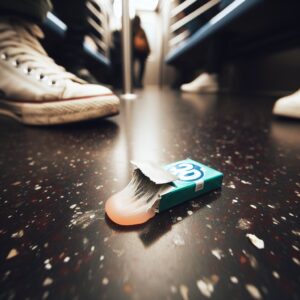The prevalence of chewed gum adhered to public transport seating is indicative of a broader lack of civic responsibility. Each little lump represents an individual decision to disregard communal well-being for private ease. Discarded gum can harbor bacteria, leading to hygiene concerns. The maintenance effort required to remove these stubborn spots drains resources and time that could otherwise be invested in general service improvements.
Current Cleaning Conundrums
The most straightforward method for removing gum has traditionally been manual scraping. This labor-intensive approach often requires cleaners to use tools like putty knives or brushes to physically pry the gum from the surface of the seat. The manual method is not without its drawbacks. It is time-consuming, leading to increased labor costs and potentially longer periods where vehicles must be taken out of service for cleaning. There is a considerable risk of damaging the seat material. Repeated scraping can fray fabrics and degrade cushioning, resulting in a need for more frequent seat replacements.
Chemical solvents offer an alternative means of dealing with gum deposits, breaking down the gum’s sticky composition to allow for easier removal. Their use introduces potential issues. The chemicals can emit fumes that may be harmful if inhaled, requiring adequate ventilation and protective gear for the cleaning staff. These solvents can be harsh on seat materials, compromising their integrity and appearance over continued use. There’s the matter of environmental impact, as the use of chemical solvents must be managed to avoid contributing to pollution.
Freezing is another technique used to solidify gum, making it brittle and easier to chip away from the seat surface. This can be done with refrigerant sprays designed specifically for this purpose. While this method is seen as being more fabric-friendly than chemicals or scraping, it does necessitate specialized equipment and can still be time-consuming. The effectiveness of freezing can vary depending on the type of gum and the material of the seat, offering inconsistent results.
Protective Seat Coatings
The technology behind these coatings is relatively straightforward yet incredibly effective. They work by creating a clear, durable layer over the fabric that repels substances that would otherwise cling to and penetrate the fibers. The repellent nature of the coating means that gum when left behind by a passenger, will not bond tightly with the seat’s surface. During the cleaning process, it can be removed with greater ease and with less damage to the underlying material.
These coatings can last for a significant period, withstanding the daily wear and tear of countless passengers coming and going. This durability is more cost-effective in the long run, as the need for frequent intensive cleaning or seat replacement is greatly reduced.
These advanced coatings are applied by professionals specialized in transport maintenance. The application process must be precise to ensure uniform coverage and optimal performance. After being treated, the seats need a certain amount of time to dry before they can be returned to service, requiring strategic timing from transport authorities to minimize disruptions.
High-quality protective seat coatings are designed to be non-toxic and safe for passengers. The materials used are rigorously tested to comply with health and safety standards, ensuring that they do not pose any risk of irritation or harm to commuters.
 Public Awareness Campaigns
Public Awareness Campaigns
Passengers may often overlook the impact of a single piece of disposed gum. Through thoughtfully designed messages that illustrate the collective outcome of these individual acts, citizens can gain a broader perspective of the communal harm they cause.
A successful public awareness campaign hinges on its ability to engage with the community in an accessible manner. This usually involves a mix of strategies, including eye-catching posters placed within the transport vehicles and stations, informative leaflets, and digital outreach through social media platforms. It must be firm enough to convey the seriousness of the matter while avoiding an overly authoritative voice that could alienate the target audience.
The involvement of local figures, such as city officials or popular local personalities, can lend credibility and resonance to the campaign. When figures who are respected within a community vocalize their support for maintaining a clean transit environment, their endorsement can spur others to follow suit.
Interactive elements such as public pledges, where commuters commit to keeping the environment clean, or competitions with rewards for the cleanest line or vehicle, can play a significant part in engaging the public. These initiatives make participants active stakeholders in the cleanliness of their transport system, providing a sense of ownership and responsibility.
Teaching children and young adults about appropriate waste disposal and civic responsibility can have long-lasting effects, as these lessons become ingrained from an early age. School programs and collaborations with educational institutions ensure that these principles are part of the community ethos.
Design Innovations
The latest developments have introduced materials that are less porous and smoother, leaving fewer crevices where gum can adhere and become entrenched. These modern fabrics can be treated with finishes that repel gum, making any pieces that are left behind far easier to remove without leaving a stain or residue.
Designers are creating seating that discourages passengers from sticking gum to them, either by making it uncomfortable or by using textures that make the adherence of gum less likely. Strategic placement of ridges or patterns on the seats can deter people from leaving gum behind since it would be more visible to cleaning staff and fellow passengers, thus increasing the embarrassment factor of being caught.
Some seats are modular and can be removed or disassembled easily. This feature allows for deep cleaning outside of the vehicle, which can provide a more thorough result without the need for a vehicle to be taken out of operation during peak usage times.
Easily accessible trash receptacles that are specifically marked for gum disposal are an example of a design addition that could encourage proper behavior. If given a convenient and clear option, passengers might be less inclined to dispose of their gum inappropriately.
Well-lit interiors can discourage people from engaging in acts of littering. Bright and visible spaces psychologically promote cleanliness and reduce the likelihood of gum litter, as people feel more observed and accountable for their actions in such environments.



